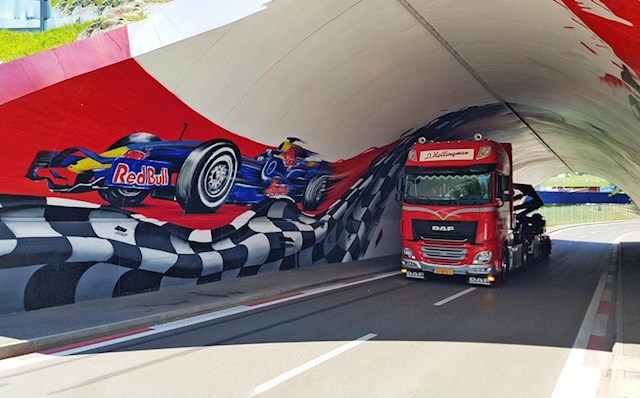Improved F1 logistics with Sideloaders
Formula 1 is a billion-dollar industry, and if we take the Ferrari team as an example, their turnover within F1 is a staggering USD 1.3 billion. Transporting the miniature village set up prior to every race requires speed and exact precision. The slightest disruption can mean the difference between success and failure out on the track. So it’s no surprise that the F1 teams spend huge amounts of money on logistics solutions to enable them to move their whole entourage from one continent to another in the space of just a few days. It’s not just a matter of garage and pit facilities for the cars. The F1 teams transfer whole buildings such as offices, bars, restaurants, solutions for electronics and IT, and more.
Once a race has concluded, everything is dismantled, packed into containers and transported on to the next venue.
With such requirements for mobility and efficiency and with so much already being transported in containers, sideloaders are an ideal fit for the logistics chain.
STS on F1 assignment in the USA
Swinglift Transport Service in Dallas transported containers using sideloaders for the F1 grand prix in Austin in 2018. The company’s CEO Bruce McGregor feels that sideloaders are an excellent resource for making the finely-tuned F1 logistics even more efficient. The company has numerous events companies among its list of customers who choose to move equipment using sideloaders, as it is quick and easy.
STS has eight sideloaders in total, and its head office is in Dallas, Texas. Thanks to the success of its sideloaders the company has recently expanded, with a new office in Nashville, Tennessee.
“We have a wide variety of customers. These include construction companies, international freight companies, small firms that use containers for transport and storage, logistics companies that need assistance with loading and unloading containers, and then we have a number of logistics assignments linked to various events. And the list goes on,” says Bruce.
You carried out F1 transport services for the grand prix in Austin last year, how did you get the assignment?
“It was a company in Canada that contacted us on behalf of DHL. A large quantity of containers needed moving in a very short space of time.”
Tell us about your role in the huge F1 logistics chain?
“Containers came from Houston on trailers. We lifted the containers off and set them on the ground. The highly efficient DHL team emptied the contents from the container and we then lifted the empty container back onto the trailer chassis, which subsequently travelled back to Houston (a distance of 200 miles/approx. 322 km). We did the same thing for 40 containers in all and it was an extremely fast and smooth process. Sideloaders were the perfect solution for this task.”
Can you clarify why sideloaders were so good for this particular assignment?
“The fact that it’s so simple to manoeuvre and set down the container exactly where the forklift wants it. Sideloaders work much faster than an ordinary crane, which would have been the alternative. Moreover, a sideloader can operate in tight spaces without causing any damage to the container or its cargo.”
What potential do you see for using sideloaders at future F1 events?
“Since it involves transfers every week during the season, the teams have become highly proficient at what they do. If you add in our services using sideloaders, that makes them even more efficient, and naturally it also gives a boost to us and other companies that use sideloaders. The events industry has become a major component of our operations. We have numerous events companies who store their equipment in containers, since it’s cheaper, for one thing, and it’s also simple to transfer the container(s) to the next location using sideloaders.”
